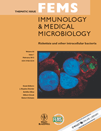Developing a new clinical tool for diagnosing chronic Q fever: the Coxiella ELISPOT
Abstract
Definitively establishing a clinical diagnosis of chronic Q fever remains challenging, as the diagnostic performance of both conventional serological tests and PCR is limited. Given the importance of an early diagnosis of chronic Q fever, there is a need for a reliable diagnostic test. We developed an enzyme-linked immunospot assay to measure Coxiella burnetii (C. burnetii)-specific T-cell responses (Coxiella ELISPOT) to both phase I and phase II antigens and tested convalescent Q fever patients (without chronic disease, n = 9) and patients with an established diagnosis of chronic Q fever (n = 3). The Coxiella ELISPOT adequately identified convalescent Q fever patients from healthy controls by demonstrating C. burnetii-specific T-cell interferon-γ production to both phase I and phase II antigens. Compared to convalescent Q fever patients, chronic Q fever patients showed a distinct Coxiella ELISPOT profile characterized by a much higher spot count for both phase I and phase II (18-fold for phase II, 8-fold higher for phase I) and a consistent shift towards more phase I reactivity. The diagnostic potential of the Coxiella ELISPOT is promising and warrants further investigation.




